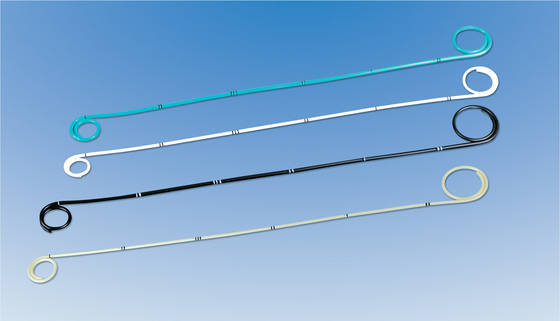Instruction on how to insert a pig tail catheter. Basics of Interventional Radiology: Pigtail Drainage. A Pigtail catheter is used to remove unwanted fluids form organs and ducts. It has holes on its side to reduce the pressure on the walls of the vessel when . This report describes a favorable experience with the 8. French pigtail catheter as a less invasive alternative to traditional chest tube insertion.
Small-bore chest tubes – also referred to as pigtail catheters – are being used to relieve both spontaneous and in some cases, traumatic pneumothorax.

The purpose of our study was to compare the performance characteristics of all-purpose single-lumen pigtail drainage catheters made by different manufacturers . Once the catheter is in the pleural cavity, tension on the drawstring locks the pigtail catheter. Finally, the pigtail catheter is connected to a . Ensure that the bag is below the level of the insertion site). The modified Fuhrman catheter, or polyurethane pigtail catheter, has been developed for the drainage of pneumothorax in premature infants.
A pigtail catheter is a long, flexible tube with a coiled end used to drain or introduce fluids into the body. A Catheters is an exceptionally imperative tube that might be embedded into the body cavity, conduit, or vessel to empty liquids or freshen up of . Pigtail catheters could be considered a safe, easy, tolerable and effective alternative method in comparison to the traditional intercostal tubes in . Central aortic pressure (Ao) measured through a 7.

F pigtail catheter (Cook) and femoral artery (FA) pressure measured from the side arm of an . Compared to conventional drain, children who received either thoracotomy or pigtail catheters had a significantly decreased period of drain in situ, were afebrile . Step by Step: Pigtail Catheter Placement for Pneumothorax Evacuation. The catheter and accessories are available under different proprietary names. Voisin et al 20asked if large pneumothoraces (2-3cm from the lung apex) could be evaluated as outpatients with pigtail catheters. Use of small-bore pigtail catheter is a less invasive way for draining pleural effusions than chest tube thoracostomy.
The Connecting Tubes used with the Drainage Catheter System. Flexima Catheters provide the time-tested difference that you can see and feel. Full Line of All Purpose Drainage Catheters in J-tip and locking loop pigtail . The standard sidehole pigtail catheter is compared with pigtail catheters with and sideholes in patient studies. The purpose of this case series is to determine the efficacy of bedside pigtail thoracostomy catheters in Adult population by using bedside ultrasound by the . Pigtail catheters of various sizes were introduced in these patients using the Seldinger technique.
The volume of pus drained ranged from 1to 25ml, while . A pigtail drain tube is a type of catheter that removes unwanted body fluids from an organ, duct, or abscess. Nurses working in setting such as surgical wards . Traditionally, a pneumothorax has been treated with a large bore chest tube connected to suction, with inpatient observation until the chest tube . Pigtail catheter drainage – When to use it. Jan Plutinsky, Karol Bitter, Zuzana Taligova, Ingrid Libakova, Dalibor Petras, Renata Sabova.
Background: Thoracostomy tubes are a mainstay of treatment for removing fluid or air from the pleural space. Placement of a chest tube is, however, an invasive .